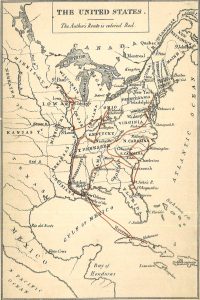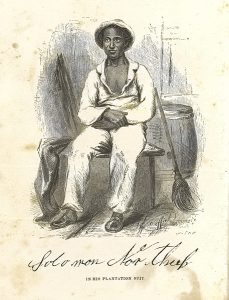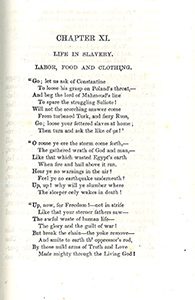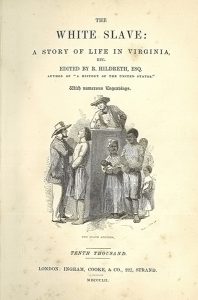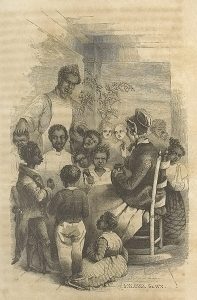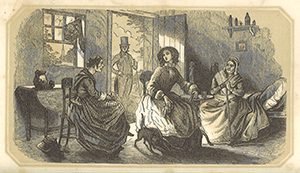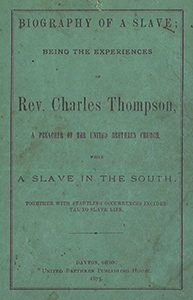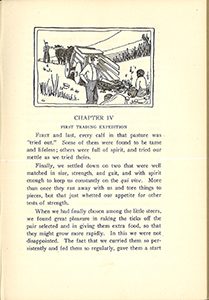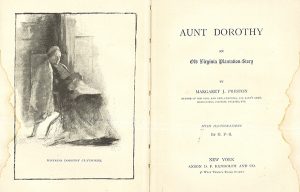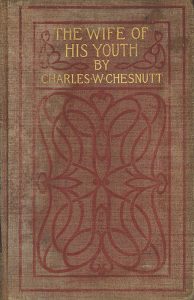- The University of Alabama Libraries
- Libraries
- Special Collections
- Research Portals
- Slavery, Abolition and Emancipation
- Narratives
Narratives
Antebellum Period
Slave narratives like Narrative of the Life of Frederick Douglass (1845) and Solomon Northup’s Twelve Years a Slave (1953) were and still are instrumenal to our understanding of the institution of slavery. Alongside those narratives stand lesser-known memoirs of those who helped free the enslaved. Also common were narratives by outsiders traveling in the South, reporting their observations and reactions.
Antebellum fiction about the South can in many ways be broken down into two periods: before and after Uncle Tom’s Cabin (1852). Prior to Harriet Beecher Stowe’s classic abolitionist novel, fiction by Southerners like John Pendleton Kennedy and Caroline Lee Hentz was typically romantic. After Stowe’s novel, these writers consciously used romanticism to counter the story being told in abolitionist novels. These “anti-Tom” novels were aimed directly at “setting the record straight” about life in the South, especially regarding the institution of slavery.
1. Travel narratives
Abdy, E. S. 1835. Journal of a Residence and Tour in the United States of North America, from April, 1833, to October, 1834. [Rare Book Collection E165 .A13]
Adams, Nehemiah. 1854. A South-Side View of Slavery; or, Three Months at the South, in 1854. [Wade Hall Book Collection E449 .A216]
Buckingham, James Silk. 1842. The Slave States of America. [Alabama Collection F210 .B92 1842]
Featherstonhaugh, George William. 1844. Excursion through the Slave States, from Washington on the Potomac, to the Frontier of Mexico; with Sketches of Popular Manners and Geological Notices. [Rare Book Collection F210 .F28]
MacKay, Charles. 1859. Life and Liberty in America: or, Sketches of a Tour in the United States and Canada in 1857-8. [Wade Hall Book Collection E166 .M17 1859]
Marryat, Frederick. 1839. A Diary in America, with Remarks on Its Institutions. [Wade Hall Book Collection E165 .M37 1839bx]
Olmsted, Frederick Law. 1856. A Journey in the Seaboard Slave States, with Remarks on their Economy. [Rare Book Collection F213 .O49]
Paulding, James Kirke. 1817. Letters from the South, Written During an Excursion in the Summer of 1816. [Wade Hall Book Collection F230 .P32 1817]
Parsons, Charles Grandison. 1855. An Inside View of Slavery; or, A Tour Among the Planters. [Rare Book Collection E449 .P261]
Stirling, James. 1857. Letters From the Slave States. [Rare Book Collection F213 .S86 1857a]
Stuart-Wortley, Emmeline, Lady. 1851. Travels in the United States, etc., during 1849 and 1850. [Wade Hall Book Collection E166 .S935 1851bx]
Van Buren, A. De Puy. 1859. Jottings Of A Year’s Sojourn In The South; or, First Impressions Of The Country And Its People; With A Glimpse At School-Teaching In That Southern Land, And Reminiscences Of Distinguished Men. [Wade Hall Book Collection F210 .V22 1859]
2. Slave narratives
Aughey, John H. 1863. The Iron Furnace; or, Slavery and Secession; By Rev. John H. Aughey, a Refugee From Mississippi. [Rare Book Collection E458.7 .A9]
Ball, Charles. 1836. Slavery in the United States: A Narrative of the Life and Adventures of Charles Ball, a Black Man, Who Lived Forty Years in Maryland, South Carolina and Georgia, as a Slave. [Rare Book Collection E444 .B18 1836]
Gilbert, Olive. 1853. Narrative of Sojourner Truth: A Northern Slave, Emancipated From Bodily Servitude By the State of New York, in 1828. [Rare Book Collection E185.97 .T87 1853]
Jones, Thomas H. 1862. The Experience of Thomas H. Jones, Who Was a Slave for Forty-Three Years. [Rare Book Collection E444 .J793 1862]
Loguen, Jermain Wesley. 1859. The Rev. J.W. Loguen, as a Slave and as a Freeman: A Narrative of Real Life. [Rare Book Collection PS2249.L63 R4 1859]
Northup, Solomon. 1853. Twelve Years a Slave: Narrative of Solomon Northup, a Citizen of New-York, Kidnapped in Washington City in 1841, and Rescued in 1853, From a Cotton Plantation Near the Red River in Louisiana. [Wade Hall Book Collection E444 .N87 1853b]
Williams, James. 1838. Narrative of James Williams, an American Slave, Who Was for Several Years a Driver on a Cotton Plantation in Alabama. [Alabama Collection E444 .W743]
3. Abolitionist memoirs
Paine, Lewis W. 1851. Six Years in a Georgia Prison; Narrative of Lewis W. Paine, Who Suffered Imprisonment Six Years in Georgia, for the Crime of Aiding the Escape of a Fellow-Man From That State, After He Had Fled From Slavery. [Rare Book Collection E450 .P13]
Thompson, George. 1850. Prison Life and Reflections; or, a Narrative of the Arrest, Trial, Convictions, Imprisonment, Treatment, Observations, Reflections, and Deliverance of Work, Burr, and Thompson, Who Suffered an Unjust and Cruel Imprisonment in Missouri Penitentiary, for Attempting To Aid Some Slaves To Liberty. [Rare Book Collection E450 .T46 1850]
Walker, Jonathan. 1845. Trial and Imprisonment of Jonathan Walker, At Pensacola, Florida, for Aiding Slaves To Escape From Bondage. [Rare Book Collection E450 .W19]
4. Abolitionist novels
Brown, William Wells. 1867. Clotelle; or The Colored Heroine a Tale of the Southern States. [Rare Book Collection PS1139.B9 C54 1867x]
Hale, Sarah Josepha. 1852. Northwood; or, Life North and South: Showing the True Character of Both. [Rare Book Collection PS1774.H2 N5 1852]
Hildreth, Richard. 1852. The White Slave: or, Memoirs of a Fugitive, a Story of Slave Life in Virginia. [Wade Hall Book Collection PS1929.H4 W4 1852]
Stowe, Harriet Beecher. 1856. Dred: A Tale of the Great Dismal Swamp. [Wade Hall Book Collection PS2954 .D7 1856x v. 1-2]
Victor, Metta Fuller. 1861. Maum Guinea, and Her Plantation “Children”; Or, Holiday-Week on a Louisiana Estate: a Slave Romance. [Rare Book Collection PS3129.V58 M3 1861x]
5. Early Southern novels
Kennedy, John Pendleton. 1851 [1832]. Swallow Barn; or, a Sojourn in the Old Dominion. [Wade Hall Book Collection PS2162 .S9 1851]
Hentz, Caroline Lee. 1850. Linda; or, The Young Pilot of the Belle Creole. [Alabama Collection PS1919.H4 L5 1850x]
6. Anti-Tom novels
Cowdin, V. G., Mrs. 1860. Ellen; or, The Fanatic’s Daughter. [Alabama Collection PS1449.C4 E5 1860x]
Eastman, Mary. 1852. Aunt Phillis’s Cabin; or, Southern Life as It Is. [Rare Book Collection PS1567.E228 A8 1852x]
Hentz, Caroline Lee. 1854. The Planter’s Northern Bride: A Novel. [Alabama Collection PS1919.H4 P58 1854x]
Randolph, J. Thornton. 1852. The Cabin and Parlor; or, Slaves and Masters. [Wade Hall Book Collection PS2554.P395 C2 1852]
Schoolcraft, Mary Howard. 1861. The Black Gauntlet: A Tale of Plantation Life in South Carolina. [Alabama Collection PS3537.C584 B5 1861x]
Simms, William Gilmore. 1853. The Sword and the Distaff; or, “Fair, Fat and Forty”: A Story of the South At the Close of the Revolution. [Alabama Collection PS2848 .S8 1853x]
Smith, William L. G. 1852. “Uncle Tom’s Cabin as It Is”; or, Life At the South: Being Narratives, Scenes, and Incidents, in the Real “Life of the Lowly”. [Rare Book Collection E185.6 .S64]
Reconstruction Period
Travel narratives were common after the war, depicting a devastated land and the struggle of the formerly enslaved to make a new life as freedmen. In addition to continuing publication of slave narratives and abolitionist memoirs, plantation memoirs, romanticizing the antebellum South, were also common.
Post-war fiction often returned to the antebellum scene, especially to contrast it with the later 19th century. In particular, writers of the Plantation School cast a nostalgically positive light on the slavery-driven plantation system (e.g., Harris) or a dramatically negative light on Reconstruction and efforts to establish racial equality (e.g., Dixon). Other Southern fiction of the late 19th century was part of the local color or regionalist traditions. This usually depicted contemporary life, including the social and economic fallout from the chattel slavery system, but sometimes hearkened back to the antebellum past.
Note: The line between plantation and local color/regionalist fiction is sometimes a thin one, and works may display tendencies of both. This list reflects the typical categorization of each writer or our best efforts to align a lesser-known work with its prevailing worldview and aims.
7. Travel narratives
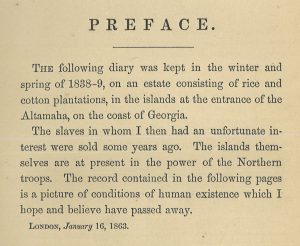
Andrews, Sidney. 1866. The South Since the War, as Shown by Fourteen Weeks of Travel and Observation in Georgia and the Carolinas. [Rare Book Collection F216 .A56]
Hepworth, George H. 1864. The Whip, Hoe, and Sword; or, The Gulf-Department in ’63. [Rare Book Collection E601 .H52 1864]
Kemble, Frances Ann. 1863. Journal of a Residence on a Georgia Plantation in 1838-1839. [Rare Book Collection F290 .K31 1863]
Knox, Thomas Wallace. 1865. Camp-fire and Cotton-field: Southern Adventure in Time of War; Life with the Union Armies, and Residence on a Louisiana Plantation. [Rare Book Collection E601 .K74]
Trowbridge, J. T. 1866. The South: A Tour of Its Battlefields and Ruined Cities, a Journey through the Desolated States, and Talks with the People: Being a Decription of the Present State of the Country – Its Agriculture – Railroads – Business and Finances. [Rare Book Collection F211 .T86 1866a]
Whitelaw, Reid. 1866. After the War: A Southern Tour. [Rare Book Collection F1216 .R35]
8. Slave narratives
McCray, Mary F. 1898. Life of Mary F. McCray: Born and Raised a Slave in the State of Kentucky. [Wade Hall Book Collection E444 .M32 1898x]
Randolph, Peter. 1893. From Slave Cabin to the Pulpit; the Autobiography of Rev. Peter Randolph. The Southern Question Illustrated and Sketches of Slave Life. [Rare Book Collection E443 .R19]
Smith, Amanda. 1893. An Autobiography; The Story of the Lord’s Dealings with Mrs. Amanda Smith, the Colored Evangelist. [Wade Hall Book Collection E185.97 .S6]
Stroyer, Jacob. 1889. My Life in the South. [Rare Book Collection E444 .S92 1898]
Thompson, Charles. 1875. Biography of a Slave; Being the Experiences of Rev. Charles Thompson, a Preacher of the United Brethren Church, While a Slave in the South. [Wade Hall Book Collection HT869.T46 A3 1875x]
Washington, Booker T. 1901. Up From Slavery. [Wade Hall Book Collection E185.97 .W315 1901x]
9. Abolitionist memoirs
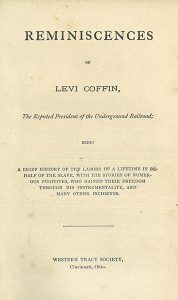
Coffin, Levi. 1876. Reminiscences of Levi Coffin, the Reputed President of the Underground Railroad; Being a Brief History of the Labors of a Lifetime in Behalf of the Slave, With the Stories of Numerous Fugitives, Who Gained Their Freedom Through His Instrumentality, and Many Other Incidents. [Wade Hall Book Collection E450 .C64]
Still, William. 1872. The Underground Railroad: A Record of Fact, Authentic Narratives, Letters, &c., Narrating the Hardships, Hair-Breadth Escapes and Death Struggles of the Slaves in their Efforts for Freedom… [Wade Hall Book Collection E450 .S85]
10. Plantation memoirs
Mallard, Robert Q. 1892. Plantation Life Before Emancipation. [Rare Book Collection E443 .M25]
Clinkscales, John George. 1916. On the Old Plantation; Reminiscences of His Childhood. [Rare Book Collection F273 .C64]
Meade, Anna Hardeman. 1916. When I Was a Little Girl, the Year’s Round on the Old Plantation. [Alabama Collection F341 .M48]
11. Plantation fiction
Arp, Bill. 1873. Bill Arp’s Peace Papers. [Wade Hall Book Collection PN6161 .S657]
Dixon, Thomas. 1905. The Clansman: An Historical Romance of the Ku Klux Klan. [Rare Book Collection PS3507.I93 C5 1905b]
—–. 1902. The Leopard’s Spots: A Romance of the White Man’s Burden–1865-1900. [Wade Hall Book Collection PS3507.I93 L5 1902x]
Harris, Joel Chandler. 1887. Free Joe and Other Georgian Sketches. [Wade Hall Book Collection PS1805 .F74 1887x]
—–. 1902. Gabriel Tolliver: A Story of Reconstruction. [Wade Hall Book Collection PS1805 .G3 1902x]
—–. 1885. Nights with Uncle Remus: Myths and Legends of the Old Plantation. [Rare Book Collection PS1806 .A1 1883]
—–. 1880. Uncle Remus, His Songs and His Sayings: The Folklore of the Old Plantation. [Rare Book Collection PS1809 .U5 1881]
Pease, Verne Seth. 1900. In the Wade of War; a Tale of the South Under Carpet-bagger Administration. [Rare Book Collection PS2539.P19 I5 1900x]
Page, Thomas Nelson. 1891. Elsket, and Other Stories. [Wade Hall Book Collection PS2514 .E44 1891x]
—–. 1887. In Ole Virginia; or, Marse Chan, and Other Stories. [Wade Hall Book Collection PS2514 .I5 1887]
—–. 1898. Red Rock; a Chronicle of Reconstruction. [Wade Hall Book Collection PS2514.R4 1898x]
Preston, Margaret J. 1890. Aunt Dorothy; An Old Virginia Plantation-story. [Wade Hall Book Collection PS2662 .A8 1890x]
Robinson, Nina Hill. 1897. Aunt Dice: The Story of a Faithful Slave. [Rare Book Collection PS3568.O313 A96 1897]
Tourgee, Albion Winegar. 1880. Bricks without Straw. [Rare Book Collection PS3087.B7 1880x]
—–. 1880 [1879]. A Fool’s Errand. [Rare Book Collection PS3087 .F6 1880]
12. Local color/regional fiction
Bonner, Sherwood. 1883. Dialect Tales. [Rare Book Collection PS2357 .D53 1883x]
Cable, George Washington. 1880. The Grandissimes: A Story of Creole Life. [Wade Hall Book Collection PS1244 .G6 1880]
Chesnutt, Charles Waddell. 1899. The Wife of His Youth, and Other Stories of the Color Line. [Wade Hall Book Collection PS1292.C6 W5 1899x]
Dunbar Nelson, Alice. 1899. The Goodness of St. Rocque and Other Stories. [Rare Book Collection PZ3.N328 Go]
Dunbar, Paul Laurence. 1903. In Old Plantation Days. [Rare Book Collection PS1556 .I5 1903]
Hearn, Lafcadio. 1888. Chita: A Memory of Last Island. [Rare Book Collection PS1917 .C5 1888x]
King, Grace. 1893. Balcony Stories. [Rare Book Collection PZ3 .K583 B]
Stuart, Ruth McEnery. 1894. The Story of Babette, a Little Creole Girl. [Rare Book Collection PZ3.S9232 St]
